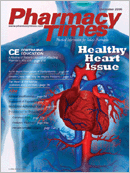Publication
Article
Pharmacy Times
HYPERTENSION WATCH
Add PUFAs to Your Diet toReduce BP
Scientists at the University of Milan, Italy, have foundthat heart failure patients whose diets were supplementedwith polyunsaturated fatty acids (PUFAs)showed substantial developments in their heart ratesand blood pressure (BP) levels. The research also suggeststhat PUFAs in daily meals help lower the risk ofarrhythmias in heart attack survivors. The researchersstated that this is due to an improvement of reflex in thearterial baroreceptors, which monitor changes in BP.
The study involved 15 patients who received 2 g/dayof PUFA in their diets, compared with 10 patients whoreceived a placebo. Each group underwent similar BP,electrocardiogram, and baroreceptor reflex assessments.The researchers found that those who atePUFA-enriched meals for 4 months were more likely toexperience improvements in both heart rates and BPreadings. The findings were published in the October17, 2006, issue of the Journal of the American Collegeof Cardiology.
Links Between Sleep Problems and BP Found in Adults and Children
A study that examined the rates of high blood pressure (BP)and sleep apnea in patients with chronic kidney disease (CKD)found that there are many instances of the 2 conditionsappearing together. The study of more than 720,000 adultsdivided into 5 subgroups?no CKD and stages I to IV CKD?found that, in every group, most of those who had sleep apneaalso had high BP?from 51% in the no CKD group, to 100% inthe stage IV CKD group. The researchers determined thathypertension is common in patients with sleep apnea. Theyalso noted that rates of hypertension increased as kidney functiondecreased. The study was conducted by the Division ofNephrology and Hypertension at the Kaiser Permanente LosAngeles Medical Center.
A separate study of hypertensive children by the Universityof Texas Medical School at Houston showed that 60% of themhad a condition known as sleep-disordered breathing (SDB),which is characterized by short periods of complete or partialupper airway obstruction or a longer period of insufficient airmovement. Risk factors for SDB in children include obesity andenlarged tonsils, and symptoms include snoring, restless sleep,morning headaches, and excessive daytime sleepiness.
Researchers studied 15 boys and 5 girls, aged 4 to 18 years,with primary hypertension who snored or had enlarged tonsils ornighttime high BP. They found that 12 of the children had SDB.The prevalence of SDB in children in general is 2%. The findingsof both studies were presented in October at the American HeartAssociation's 60th Annual Fall Conference of the Council for HighBlood Pressure Research in San Antonio, Tex.
To Lower BP?Don't Worry, Be Happy
A recent study shows that having apositive outlook on life not only makes itmore enjoyable, it may make it longer bylowering blood pressure (BP) levels. Thestudy involved 2654 Mexican Americansaged 65 and older who answered aquestionnaire that measured their levelof positive emotions.
The researchers found that the higherpeople scored on the test, the lowertheir BP was. The results were most significantfor people who were not takingBP-lowering medications, but they werealso notable among those who weretaking the medicines.
The lead author of the study, Glenn V.Ostir, PhD, of the University of TexasMedical Branch in Galveston, stated,"Our thoughts and emotions do affectour physical processes. The nice thing isthat we have some control over that." Dr. Ostir and his team suggest that targetinga patient's emotional well-beingcould be an effective way to help themcontrol their BP. The findings were publishedin the September/October 2006edition of Psychosomatic Medicine.
ACE Inhibitors Also Aid inType 2 Diabetes
A study conducted at theMario Negri Institute for PharmacologicalResearch inBergamo, Italy, showed thatpatients who have both highblood pressure (BP) and type 2diabetes benefit from taking anangiotensin-converting enzymeinhibitor (ACEI) for their BP. Theuse of ACEIs and control of highBP appear to have independentand additive protective effectsin patients with type 2 diabetes.
The study involved 1180patients with type 2 diabeteswho also had high BP. Theresearchers found that thosewho were taking the ACEI trandolapril,alone or with verapamil,experienced a delay inthe onset of microalbuminuria?a buildup of albumin inthe urine that signals kidney disease.Diabetes is a leadingcause of kidney disease.
According to Piero Ruggenenti,MD, the study's leadauthor at the Institute, "effectiveBP reduction has a specific?effect against the developmentof microalbuminuria." Systolic BPitself was the strongest predictoror microalbuminuria, and itsreduction was the most protectivefactor. The findings werepublished in the December 2006edition of the Journal of theAmerican Society of Nephrology.







